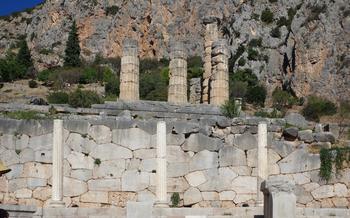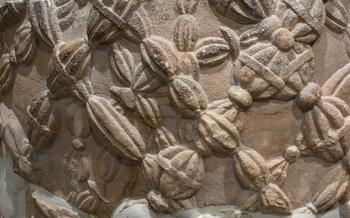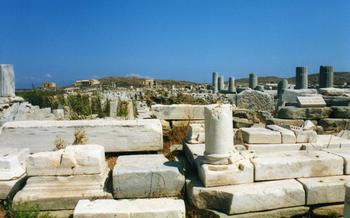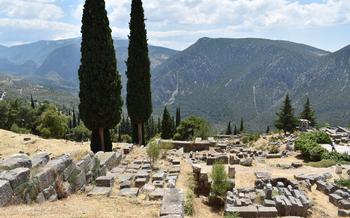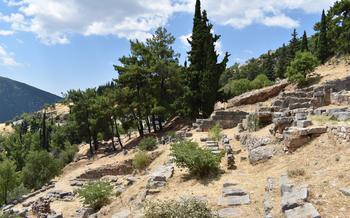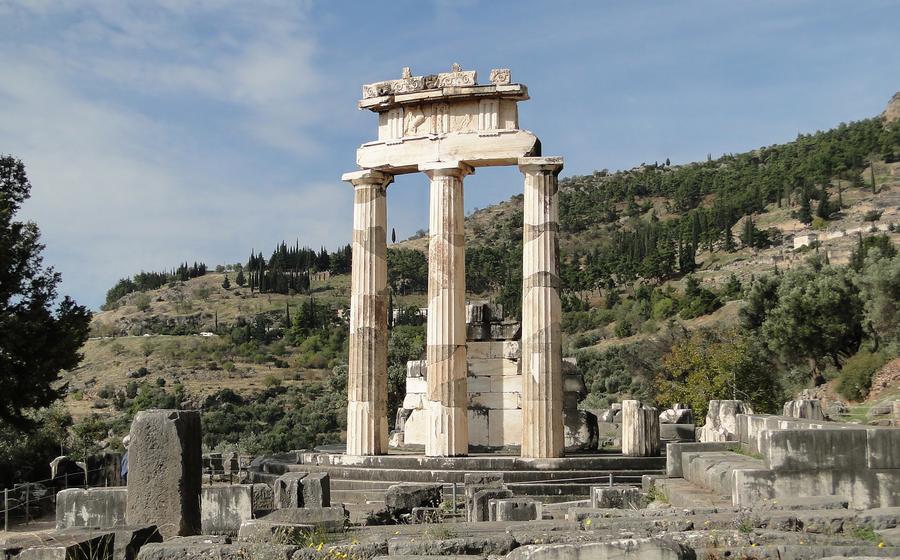
Tholos of Delphi
- Delphi: A Place of Antiquity and Wonder
- Unveiling the Tholos of Delphi: A Masterpiece of Architecture
- Exploring the Sacred Precinct of Delphi: Where Gods and Legends Reside
- Ascending to the Oracle: The Heart of Delphi
- Marveling at the Athenian Treasury: A Testament to Architectural Prowess
- Marveling at the Tholos Murals: Glimpses into Ancient Greek Art
- The Stoa of the Athenians: A Place of Philosophical Discourse
- The Castalian Spring: A Source of Inspiration and Purification
- The Museum of Delphi: A Treasure Trove of Ancient Artifacts
- The Sacred Way: A Path of Pilgrimage and Procession
- The Theater of Delphi: A Stage for Performances and Civic Gatherings
- The Stadium of Delphi: A Place of Athletic Contests
- Hiking Mount Parnassus: A Journey into Nature and Mythology
- Insider Tip: Visiting Delphi During the Off-Season
Delphi: A Place of Antiquity and Wonder
In the heart of Greece, nestled amidst the picturesque landscapes of Central Greece, lies the ancient city of Delphi. Renowned as the most significant religious sanctuary in the classical world, Delphi holds a profound historical and cultural significance. Its reputation as a spiritual and intellectual center, coupled with its impressive archaeological treasures and breathtaking natural surroundings, captivates visitors and transports them back to the glorious era of ancient Greece.
As one of the most important Panhellenic sanctuaries, Delphi served as a sacred oracle, where the enigmatic Pythia, the oracle of Apollo, delivered prophecies that shaped the course of history. The city was believed to be the center of the world, marked by the omphalos, a sacred stone representing the navel of the Earth. Its reputation as a spiritual haven attracted pilgrims, statesmen, and influential figures from across the Hellenic world, seeking guidance and divine wisdom from the oracle.
Delphi's archaeological treasures are a testament to the artistic prowess and religious fervor of the ancient Greeks. The ruins of temples, treasuries, and theaters, adorned with intricate carvings and sculptures, narrate the tales of gods and heroes, providing a glimpse into the rich mythology and culture that flourished in this sacred city.
The awe-inspiring natural surroundings of Delphi further enhance its allure. Perched on the slopes of Mount Parnassus, with the majestic peaks of the Delphian landscape as its backdrop, the city offers breathtaking panoramic views. The sacred Castalian Spring, believed to possess mystical powers, cascades down the mountain, adding to the mystical aura of this ancient sanctuary.
Prepare to embark on a journey through time as we delve into the wonders of Delphi, exploring its architectural marvels, unraveling its sacred mysteries, and immersing ourselves in the captivating stories that echo through the ages.
Unveiling the Tholos of Delphi: A Masterpiece of Architecture
The Tholos of Delphi, nestled amidst the sacred ruins of the ancient sanctuary, stands as a testament to the architectural prowess and artistic achievements of ancient Greece. Its unique circular design, comprising a cylindrical cella surrounded by a colonnade of 20 Doric columns, sets it apart from other structures at Delphi. Each column, meticulously crafted from gleaming white marble, rises majestically towards the sky, creating a sense of harmony and grandeur. The capitals, adorned with intricate moldings, add a touch of elegance and refinement to the overall structure.
The Tholos's circular form, a rarity in ancient Greek architecture, serves both aesthetic and functional purposes. It provides an uninterrupted view of the interior, allowing visitors to fully appreciate the building's design and decoration. The circular layout also enhances the acoustics within the Tholos, creating an ideal space for religious rituals and ceremonies.
The exterior of the Tholos is further embellished with a frieze of triglyphs and metopes, which originally depicted mythological scenes and stories related to the god Apollo. Although many of these sculptures have been lost or damaged over time, those that remain offer a glimpse into the rich iconography and artistic traditions of ancient Greece.
The Tholos of Delphi is not merely an architectural marvel but also holds deep religious and symbolic significance. It was dedicated to Apollo, the god of prophecy, music, and healing, and was believed to be the place where the Pythia, the oracle of Apollo, delivered her prophecies. The circular shape of the building echoed the omphalos stone, a sacred object believed to be the center of the world, which was housed within the Tholos.
Exploring the Tholos of Delphi is a journey into the heart of ancient Greek architecture and spirituality. Its unique design, exquisite craftsmanship, and symbolic significance make it a must-see for anyone interested in the history, culture, and artistic achievements of this remarkable civilization.
Exploring the Sacred Precinct of Delphi: Where Gods and Legends Reside
The Sacred Precinct of Delphi, situated at the foot of Mount Parnassus, was the religious center of ancient Greece and a place of profound spiritual significance. Dedicated to the god Apollo, the precinct was believed to be the site of the oracle, where the Pythia, or oracle, delivered divine prophecies.
The main sanctuary of Apollo, known as the Temple of Apollo, was the focal point of the precinct. This magnificent temple, constructed in the 6th century BC, housed a colossal statue of Apollo made from gold and ivory. The temple also contained the sacred omphalos, a conical stone believed to be the center of the world.
Surrounding the Temple of Apollo were numerous treasury buildings, constructed by various Greek city-states to store their wealth and offerings to the god. These treasuries were adorned with exquisite sculptures and inscriptions, showcasing the artistic prowess and wealth of the ancient Greeks.
Another significant structure within the precinct was the Stoa of the Athenians, a long, colonnaded building constructed by the Athenians to commemorate their victory over the Persians at the Battle of Marathon. The stoa served as a meeting place for philosophers and intellectuals, and its walls were decorated with vibrant paintings depicting scenes from Greek mythology.
Ascending to the Oracle: The Heart of Delphi
In the heart of the sacred precinct lies the most enigmatic and awe-inspiring structure of Delphi: the Oracle of Apollo. Here, the Pythia, a priestess chosen for her exceptional spiritual qualities, delivered prophecies that shaped the course of ancient Greek history.
Before seeking the oracle's guidance, visitors underwent elaborate rituals of purification. They bathed in the sacred waters of the Castalian Spring, adorned themselves with laurel wreaths, and offered sacrifices to Apollo.
As they approached the Oracle, a sense of anticipation and reverence filled the air. The Pythia, seated on a tripod over a chasm that emitted intoxicating vapors, entered a trance-like state, becoming a vessel for the god's words.
Her utterances, often cryptic and ambiguous, were interpreted by priests and delivered to those seeking divine guidance. Kings, statesmen, and ordinary citizens alike flocked to Delphi, seeking answers to their most pressing questions.
The oracle's influence extended far beyond Delphi, shaping political decisions, military strategies, and the lives of individuals across the ancient Greek world. Its legacy endures as a testament to the profound belief in divine guidance that permeated every aspect of ancient Greek society.
Marveling at the Athenian Treasury: A Testament to Architectural Prowess
The Athenian Treasury is a remarkable monument located in the heart of the sacred precinct of Delphi. Constructed around the mid-6th century BC, this Doric-style building epitomizes the architectural prowess of ancient Athens. Its imposing façade, adorned with intricate sculptures and vibrant colors, immediately captivates the attention of visitors.
Dedicated to Apollo, the patron deity of Delphi, the Athenian Treasury served as a repository for offerings and votives presented by the Athenian faithful. The structure's exterior is adorned with a series of six sculpted metopes, each depicting a different labor of Hercules. These exquisite reliefs, carved with meticulous precision, offer a glimpse into the mythological world of ancient Greece.
One of the most striking features of the Athenian Treasury is its well-preserved state of conservation. The building's original paint, although faded over time, still remains visible in traces, providing a rare glimpse into the vibrant colors that once adorned ancient Greek architecture.
The Athenian Treasury stands as a testament to the artistic and cultural achievements of ancient Athens and serves as a reminder of the city's enduring legacy in the realm of architecture and design.
Marveling at the Tholos Murals: Glimpses into Ancient Greek Art
The Tholos of Delphi is adorned with vibrant and colorful frescoes, offering a glimpse into the artistic achievements of ancient Greece. These well-preserved murals depict a variety of mythological scenes and deities, bringing to life the stories and legends that were an integral part of Greek culture.
The frescoes showcase the exceptional skill and artistry of the ancient Greek painters. The use of rich colors, detailed brushwork, and expressive figures conveys a sense of movement and emotion, captivating viewers with their narrative power.
One of the most notable frescoes depicts the Judgment of Paris, a famous myth involving the goddesses Hera, Athena, and Aphrodite. The scene portrays Paris, a Trojan prince, as he selects the most beautiful goddess, ultimately awarding the golden apple to Aphrodite, the goddess of love and beauty.
Another fresco of significance is the Apotheosis of Heracles, which illustrates the transformation of the mythical hero Heracles into a god. The mural captures the moment when Heracles, having completed his twelve labors, is welcomed into Mount Olympus, the home of the gods.
These frescoes not only provide valuable insights into ancient Greek mythology but also serve as a testament to the artistic prowess and storytelling abilities of the ancient Greek people. They offer a unique opportunity to connect with the past and appreciate the enduring legacy of Greek art and culture.
The Stoa of the Athenians: A Place of Philosophical Discourse
In the heart of Delphi, where history and philosophy intertwine, stands the Stoa of the Athenians, a testament to the intellectual prowess of ancient Greece. Built in the 5th century BC to commemorate the Athenian victory at the Battle of Marathon, this Doric-style stoa served as a meeting place for philosophers, intellectuals, and scholars from across the Hellenic world.
With its rows of slender columns and an expansive open space, the Stoa of the Athenians provided a serene and conducive environment for philosophical discourse and contemplation. Here, great minds like Socrates, Plato, and Aristotle gathered to exchange ideas, debate philosophical concepts, and explore the mysteries of the universe.
The stoa was not merely a physical structure but a vibrant hub of intellectual exchange, where ideas were challenged, theories were born, and knowledge was disseminated. It was a place where the pursuit of wisdom and understanding took precedence, and where the foundations of Western philosophy were laid.
As you stand among the ruins of the Stoa of the Athenians, you can almost hear the echoes of these ancient conversations, feel the energy of intellectual curiosity, and sense the profound impact that this place had on the development of human thought. It is a reminder of the enduring power of ideas and the timeless pursuit of knowledge that continues to shape our world today.
The Castalian Spring: A Source of Inspiration and Purification
Nestled amidst the sacred precincts of Delphi, the Castalian Spring held a profound significance in ancient Greek mythology and culture. Revered as a source of inspiration, purification, and spiritual renewal, this natural spring was believed to possess mystical powers. According to legend, drinking from its waters could bestow poetic gifts and enhance creativity. Many renowned poets and musicians, including Pindar and Sophocles, sought inspiration from the Castalian Spring, believing that its divine waters would elevate their artistic endeavors.
In addition to its creative associations, the Castalian Spring also played a crucial role in religious rituals and ceremonies. Before entering the sanctuary of Apollo, pilgrims and worshippers underwent a ritual purification by bathing in the spring's sacred waters. This cleansing ritual symbolized the shedding of impurities and the preparation of the soul for communion with the divine. The spring's crystal-clear waters were believed to possess a purifying and revitalizing effect, both physically and spiritually.
Beyond its religious significance, the Castalian Spring was also a place of natural beauty and tranquility. Surrounded by lush vegetation and towering mountains, the spring offered a serene and picturesque setting for contemplation and reflection. Its sparkling waters and gentle murmur created a harmonious ambiance that invited visitors to connect with nature and find inner peace.
The Museum of Delphi: A Treasure Trove of Ancient Artifacts
The Museum of Delphi is a must-visit for anyone interested in ancient Greek history and culture. The extensive collection of artifacts from Delphi and the surrounding area provides a glimpse into the daily life, culture, and beliefs of the ancient Greeks. Sculptures, pottery, jewelry, inscriptions, and more tell the story of a civilization that laid the foundation for Western thought and culture.
Among the highlights of the collection are the bronze Charioteer of Delphi, a masterpiece of ancient Greek sculpture; the marble Sphinx of Naxos, with its enigmatic smile; and the gold and ivory statue of Apollo, which once stood in the Temple of Apollo. The museum also houses a collection of inscriptions, including the famous Delphic Maxims, which offer insights into the moral and ethical values of the ancient Greeks.
Interactive exhibits and educational programs bring the ancient world to life, making the Museum of Delphi a great place for visitors of all ages to learn about ancient Greek history and culture. Whether you're a history buff, an art enthusiast, or simply curious about the ancient world, a visit to the Museum of Delphi is an unforgettable experience.
The Sacred Way: A Path of Pilgrimage and Procession
The Sacred Way was an ancient road that played a pivotal role in the religious and ceremonial life of Delphi. It served as a processional route for pilgrims and worshippers making their way from the sanctuary of Apollo to the Castalian Spring, a sacred spring revered for its purifying and inspirational properties.
Lined with an array of statues and monuments, the Sacred Way was a testament to the enduring faith and devotion of the ancient Greeks. These statues, often depicting gods, heroes, and mythological figures, added an air of sanctity and grandeur to the path, transforming it into a sacred space that inspired awe and reverence.
As pilgrims and worshippers traversed the Sacred Way, they would participate in various rituals and ceremonies, seeking divine guidance and purification. The journey along this ancient road was not merely a physical one but also a spiritual experience, a pilgrimage that connected the faithful with the realm of the gods.
Today, visitors to Delphi can still walk along the Sacred Way, retracing the steps of ancient pilgrims and immersing themselves in the sacred atmosphere that permeated this path. The ruins of the statues and monuments that once adorned the wayside serve as poignant reminders of the deep faith and devotion that characterized ancient Greek religion.
The Theater of Delphi: A Stage for Performances and Civic Gatherings
Nestled on the slopes of Mount Parnassus, the Theater of Delphi stands as a testament to the vibrant cultural and civic life of ancient Greece. Built in the 4th century BC, this impressive structure could accommodate up to 5,000 spectators, making it one of the largest theaters in the ancient world.
The theater served as a multipurpose venue, hosting a variety of performances and gatherings. It was here that theatrical productions, ranging from comedies to tragedies, brought to life the works of renowned playwrights such as Sophocles and Euripides. The acoustics of the theater were meticulously designed to ensure that every word and intonation could be heard clearly by the audience, creating an immersive and engaging experience.
In addition to theatrical performances, the Theater of Delphi also hosted musical concerts, featuring talented musicians and vocalists who entertained the crowds with their melodies and harmonies. These concerts were often accompanied by dance performances, adding a visual dimension to the auditory spectacle.
The theater was not just a place of entertainment but also served as a venue for civic assemblies and political debates. Here, citizens of Delphi and representatives from neighboring city-states gathered to discuss important issues, make decisions, and shape the course of their communities. The theater provided a platform for lively discussions, persuasive speeches, and the exchange of ideas, contributing to the democratic processes of ancient Greece.
Today, the Theater of Delphi stands as a reminder of the rich cultural heritage of ancient Greece. Although time and natural elements have taken their toll, the theater's imposing structure and impressive acoustics continue to captivate visitors, offering a glimpse into the vibrant performances and civic gatherings that once took place within its walls.
The Stadium of Delphi: A Place of Athletic Contests
In the picturesque valley of Delphi, nestled amidst the slopes of Mount Parnassus, lies the ancient Stadium of Delphi, a testament to the significance of physical prowess and sports in ancient Greece. Built in the 4th century BC, this impressive stadium is a symbol of athleticism and competition that once echoed through the sacred precincts of Delphi.
With a capacity to accommodate 5,000 spectators, the Stadium of Delphi was the proud host of the Pythian Games, one of the four major Panhellenic Games that brought together athletes and spectators from across the Hellenic world. During these prestigious events, the stadium reverberated with the cheers and roars of the crowd as competitors showcased their strength, speed, and agility in a variety of athletic disciplines.
Footraces were a highlight of the Pythian Games, with runners sprinting along the stadium's ancient track, their footsteps pounding the earth in a relentless pursuit of victory. Wrestlers grappled and strained against each other, their bodies glistening with sweat and determination, while chariot races added an element of danger and excitement as teams of horses and chariots thundered around the track, their wheels churning up the dust.
The Stadium of Delphi not only served as a venue for athletic competitions but also held cultural and religious significance. It was here that poets and musicians performed their works, honoring the gods and celebrating the achievements of athletes and victors. The stadium's presence within the sacred precinct of Delphi further emphasized the interconnectedness of athletics, religion, and the pursuit of excellence in ancient Greek society.
Today, visitors to the Stadium of Delphi can wander through the ancient tiers of seating, imagining the roar of the crowd and the spectacle of the games that once took place here. The stadium's ruins stand as a reminder of the enduring legacy of athleticism in ancient Greece and its profound influence on the development of sports and physical culture throughout the world.
Hiking Mount Parnassus: A Journey into Nature and Mythology
Mount Parnassus looms majestically over Delphi, a sanctuary dedicated to Apollo and the Muses. Steeped in mythology and natural beauty, this sacred mountain beckons hikers and nature enthusiasts alike.
As you ascend the winding trails, immerse yourself in the enchanting landscapes that unfold before you. Lush forests of pine and oak trees provide a verdant canopy, while wildflowers paint the slopes with vibrant hues. The air is fresh and invigorating, filling your lungs with the essence of nature.
Along the way, discover ancient trails and paths that were once trodden by pilgrims and worshippers seeking divine inspiration. These paths lead to hidden sanctuaries and forgotten shrines, each with its own tale to tell.
The summit of Mount Parnassus is a place of breathtaking beauty and spiritual significance. Here, you can bask in the glory of panoramic views that stretch for miles, encompassing the Gulf of Corinth, the Peloponnese, and the distant mountains of mainland Greece.
Feel the presence of the Greek Muses, who are said to have resided on these slopes, inspiring poets, musicians, and artists throughout the ages. The god Dionysus, too, is associated with this sacred mountain, his wild and ecstatic rites celebrated in ancient festivals that echoed through the forests.
Hiking Mount Parnassus is a journey into nature and mythology, a chance to connect with the ancient world and the divine forces that shaped it. Whether you're a seasoned hiker or simply seeking a peaceful retreat, this mountain offers an unforgettable experience that will leave you awestruck and inspired.
Insider Tip: Visiting Delphi During the Off-Season
While the allure of Greece during the peak tourist season is undeniable, there's a hidden charm to be discovered by visiting Delphi during the off-season. From October to April, the crowds dissipate, the temperatures become milder, and the site takes on a tranquil atmosphere that allows for a more immersive and intimate experience.
Embrace the solitude as you wander through the ancient ruins, taking your time to marvel at the intricate details and appreciate the grandeur of the site without the throngs of tourists. Capture stunning photographs without having to jockey for the perfect angle, and engage in meaningful conversations with the knowledgeable staff who are more readily available during this time.
Take advantage of the reduced prices for accommodation and transportation, making your trip more budget-friendly. Hotels and restaurants offer enticing deals during the off-season, allowing you to splurge on a luxurious stay or indulge in delicious local cuisine without breaking the bank.
With fewer visitors, you'll have ample time to explore the site at your own pace, delving deeper into the history and stories that permeate every corner of Delphi. Wander along the Sacred Way, contemplating the footsteps of ancient pilgrims, or embark on a hike up Mount Parnassus, immersing yourself in the natural beauty that inspired the Greek Muses.
Visiting Delphi during the off-season is a unique opportunity to connect with the site's profound energy and tranquility, allowing you to fully absorb the essence of this sacred place without the distractions of the crowds. So, if you seek a more authentic and enriching experience, consider venturing to Delphi during the quieter months and discover its hidden treasures.
